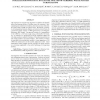1351 search results - page 12 / 271 » Learning 3D Appearance Models from Video |
ICPR
2008
IEEE
14 years 3 months ago
2008
IEEE
The importance of accurate early diagnostics of dyslexia that severely affects the learning abilities of children cannot be overstated. Neuropathological studies have revealed an ...
ICIP
2007
IEEE
14 years 10 months ago
2007
IEEE
Tracking 3D people from monocular video is often poorly constrained. To mitigate this problem, prior knowledge should be exploited. In this paper, the Gaussian process spatio-temp...
FGR
2000
IEEE
14 years 1 months ago
2000
IEEE
This paper describes a framework for constructing a linear subspace model of image appearance for complex articulated 3D figures such as humans and other animals. A commercial mo...
ICCV
2007
IEEE
14 years 10 months ago
2007
IEEE
Tumor segmentation from MRI data is an important but time consuming task performed manually by medical experts. Automating this process is challenging due to the high diversity in...
AMDO
2006
Springer
14 years 11 days ago
2006
Springer
The ability to detect and track human heads and faces in video sequences is useful in a great number of applications, such as human-computer interaction and gesture recognition. Re...

